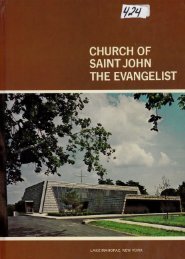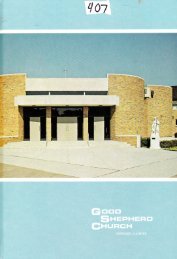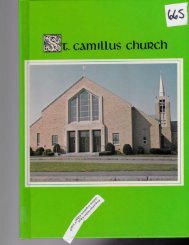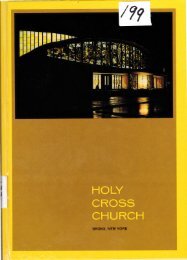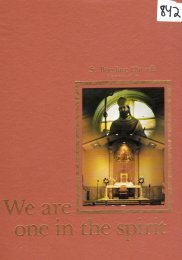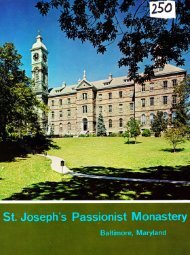Untitled - Digitizing America
Untitled - Digitizing America
Untitled - Digitizing America
You also want an ePaper? Increase the reach of your titles
YUMPU automatically turns print PDFs into web optimized ePapers that Google loves.
nineteenth century, generous parishioners<br />
donated several lots to the parish for use as a<br />
burial ground. Donors included Augustus and<br />
Agnes Jones, who made the donation in<br />
1874; Michaeland Minnie Flynn, in 1895 and<br />
1899; John and Mary Bugg, in 1899. The<br />
Flynns and Buggs stipulated that the burial lots<br />
were to be provided free of charge to parishioners<br />
of St. James.<br />
Twentieth Century<br />
Church Renovations<br />
The third church, completed in 1861 and still in<br />
use today, has undergone a number ofchanges<br />
through the years. Although there was a story<br />
that the three-tiered original tower was<br />
weakened when hit by an artillery ball during<br />
the Civil War, the tower stood until the need of<br />
repairs in 1890.<br />
In 1905 pillars were installed in the church<br />
to take the welght of the roof o{f the walls. To<br />
cover the steel rods which now hold the walls<br />
together. a false ceiling was put in.<br />
,g<br />
ll,<br />
li,<br />
Workmen repoiring the tower, circa 7895<br />
t5<br />
lnterior os it looked al the turn oJ the century<br />
This ceiling, composed of tongue-andgroove<br />
wooden planks, was considered an<br />
"amazing piece ol carpentry." The strain put on<br />
the church walls by the weight of the roof caused<br />
a bow-like effect that stillcan be seen by looking<br />
down along the outer walls.<br />
The original church was illuminated by<br />
coal-oil lamps suspended on a counter-balance<br />
system so they could be lowered for lighting.<br />
The first electric lights were introduced in the<br />
church for the silver jubilee in 1886. The other<br />
coal-oil lamps were replaced with electric lights<br />
later. Spotlights, focussing on the altar, have<br />
since been added.<br />
In 1960 twenty-five acres west of Potosi,<br />
adjoining the U. S. Forest Service Land, was<br />
deeded to the parish and the archdiocese by<br />
National Lead Industries for use as a cemetery.<br />
Walnut and pine trees have been planted there<br />
to provide beauty and income some day for<br />
cemetery maintenance. Named Calvary<br />
Cemetery, many improvements have been<br />
made on the property, including a fence, a concrete<br />
drive into the grounds, and a monument<br />
placed on the summit.<br />
Locally, Calvary Cem etery is ref erred to as<br />
the "New Cemetery," as the parish has had a<br />
cemetery nearby the church since it was established.<br />
The old cemetery was located next to the<br />
small brick church, and two blocks north of the<br />
present church. The land for the new burial<br />
ground was acquired because the f irst cemetery<br />
was filled, and some parts of the lot were inaccessible<br />
due to the closeness of rock to the<br />
ground surface.




